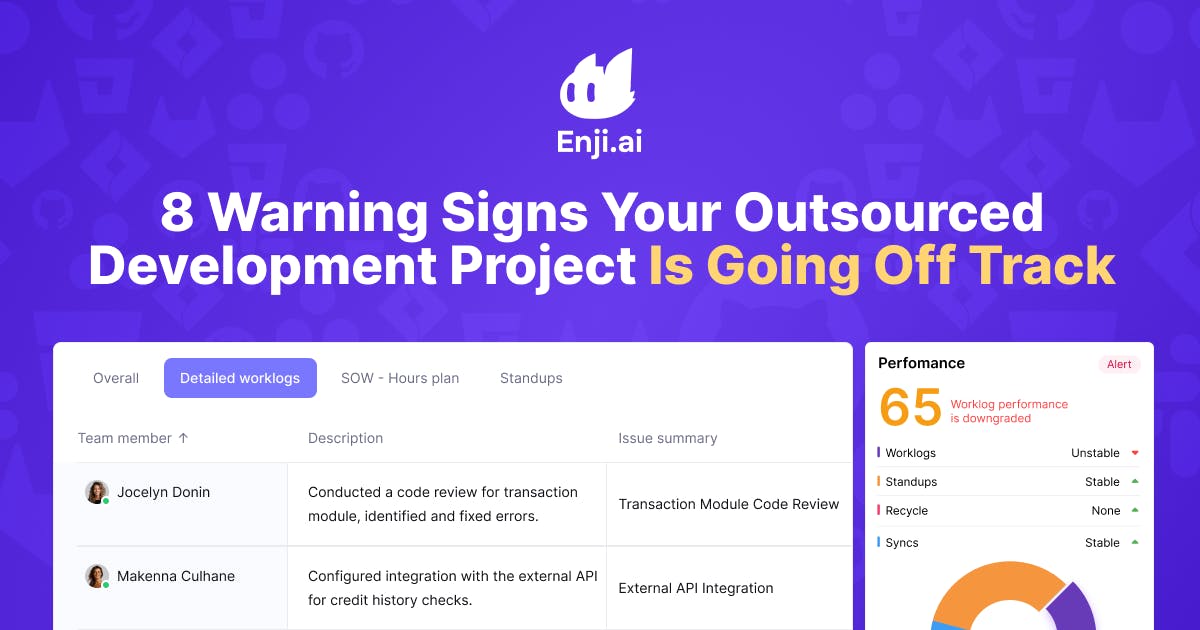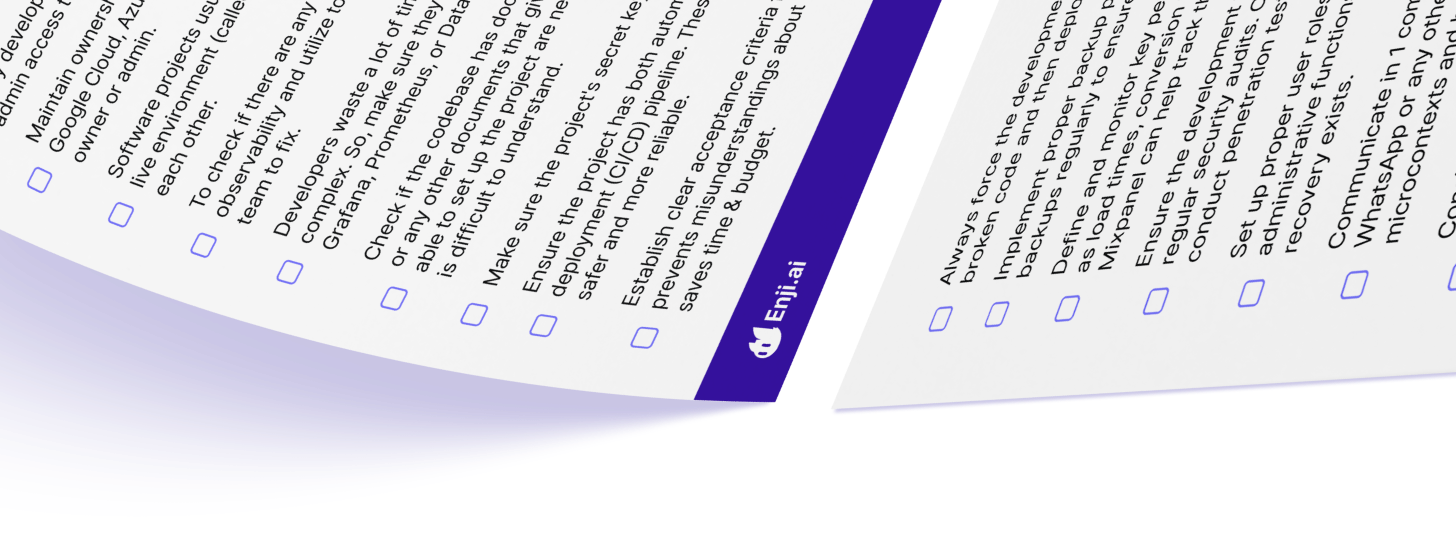8 Warning Signs Your Outsourced Development Project Is Going Off Track

Outsourced software development offers companies an excellent opportunity to cut costs and invest in the promotion of products and services without sacrificing development. Unfortunately, a recent survey of business leaders who outsource development shows it is not as simple as handing over a list of tasks to a team of developers and waiting for them to send back a ready product or solution. 28% of respondents mentioned poor communication as a concern they have in their outsourcing relationships, and less than 50% are very satisfied with their vendor arrangement. These results indicate the clear challenges that keep a company from reaping the full list of advantages of outsourcing.
Examples include misalignment with business goals and expectations, misunderstandings, and missed deadlines. To avoid these situations, stakeholders and managers need to recognize the signs that indicate when an outsourced development project is off track and when they need to take action to correct the project's course.
8 warning signs of off-track development
Regardless of where a team of outsourcers is located, in the client's country or a continent away, there is no 100% guarantee that a project will not encounter roadblocks. That is why it is necessary to understand two crucial elements of proper outsourcing risk management: transparency and communication. Before a project begins, clients need to outline their expectations in terms of what information they want to receive and when, and how they want to communicate with outsourcers.
Vendors do not want to take advantage of their clients; however, a lack of clear visibility into their work and poor communication lead to challenges in the relationship. Likewise, they typically demonstrate poor processes and other problems within the development company's workflow. Any of the signs below deserve attention and immediate action to reduce the risk of critical issues developing in a project.
1. Lack of leadership
One of the most important steps at the beginning of a project is to ensure that there are designated contact persons on the client's and vendor's sides of the relationship. This is typically a role performed by delivery and project managers. A red flag for clients is when the outsourcing company does not do this or if the contact person changes often, resulting in a loss of information and knowledge.
2. Poor deadline management
Poor deadline management is when a client and vendor do not establish clear and understandable deadlines at the beginning of a project. It is not enough to agree to see a deliverable by a certain date. The outsourcing team needs to understand why this date is important. Proper deadline management also involves clear communication when the outsourcing team cannot meet a deadline. This means they inform the client of delays. While this is unpleasant, it demonstrates that the vendor's team understands the importance of the project. "Silent" delays, when outsourcers ignore deadlines without explanations, are more significant warning signs of problems.
3. Delayed and unanswered communication
The outcome is most important in the client-outsourcer relationship; however, communication plays an important role in the process of achieving the outcome. As such, communication can be broken down into different stages: before, during, and after the project. In the beginning, the client needs to define expectations with the vendor, for example, the time it takes to respond to a message. If these expectations are not met during the project, the client must use these as a warning sign to take action before critical issues appear. The client may require follow-up communication after the project for knowledge transfer and support. If this does not happen as expected, the client may face serious problems. It is important to remember that silence is not a problem if it is expected.
4. Client kept at a distance
There are different types of distance in a project with outsourcers. The vendor team may not provide any updates until the work is complete, which is okay if this was discussed at the beginning of the project. Another situation may be that the outsourcing team provides updates without any details, such as if there are any issues. Finally, the vendor may not want to share any tangible resources, such as code, worklogs, and project hosting. This is a significant warning sign for clients that requires direct action to avoid losing control over a project.
5. Different goals of business and development teams
Before the start of a project, the client will need to provide a clear vision and value layer of the product or solution they want to receive from the outsourcers. At this point, the development team should ask about the value. Why do they need to create a certain functionality? It is a big warning sign if this does not happen, and could lead to situations where the vendor's team does what they are asked to do without understanding the product and value. This creates a large backlog, which demonstrates that the development team is not prioritizing the right tasks.
6. Lack of proper documentation
Documentation is vital in outsourcer-client relationships. It ensures that future developers, whether the client's in-house employees or other vendors, can resolve issues in a short amount of time and find answers to other questions. Effective software development teams integrate documentation into their workflows to ensure that information remains relevant. Warning signs can include incomplete or irrelevant documentation if requested or promises that the vendor's team will provide documentation at the end of the project. These are points that need to be outlined at the beginning of any collaboration to ensure that business and development teams are on the same page.
7. Regular onboarding of new team members
Outsourcers experience similar dynamics as other companies, meaning their engineers may leave during a project. This is not a problem if there are clear processes in place for knowledge transfer. However, when clients experience frequent introductions to new developers or project managers, this is a warning signal that the vendor may have larger issues within their business. This could indicate that the outsourcers are prioritizing other projects or that they have a high turnover of engineers. In either case, the result will be delays and mistakes.
8. Vague or misleading promises and updates
Clients should note what their outsourcers are saying in project updates, such as claims that the project is at "90% completion" for several weeks. Vendors may also use technical jargon to obscure status or descriptions that do not match demonstrations. Likewise, note if the team makes routine promises that include words such as "we'll fix that properly later." These are clear warning signs of underlying issues that are causing disruption to the project or that the project team may be focusing on other tasks.
Understanding these situations will help clients avoid a failed outsourcing project and extra expenses. Both clients and vendors want better products and improved performance. Outsourcing companies rely on positive reviews and recommendations from clients; therefore, their leadership wants to avoid IT project failures and the poor reputation that these create.
Keeping projects on track
Given this list of signs that a project is moving in the wrong direction, business leaders may decide that micromanagement will help reduce the chance that these situations occur. They may consider another "cure" to be physical proximity to their outsourcers. Nonetheless, instead of supporting healthy software development, these approaches will increase the costs and slow down progress.
Instead of micromanagement, clients can take advantage of positive control and observation. These are the keys to an effective client and outsourcer relationship. This means that clients and other stakeholders have access to project updates and performance without constant meetings or emails and, most importantly, without interfering in the work of developers. This is not to be confused with spying or recording screens. That creates lots of data that does not provide any real estimation of performance. Instead, clients can use tools to collect data and AI to analyze it in the background. These instruments gather information on activities within a project, such as task status changes, comments, commits, and other actions the outsourcing team should perform. Then, they provide insights into performance to help both developers and stakeholders make necessary adjustments and informed decisions.
Enji offers several convenient features to help businesses obtain complete transparency in the work of outsourcing teams. Visibility reduces the chances of any critical issues occurring and helps teams and managers resolve roadblocks. Enji provides all this information with AI-powered insights in a single platform:
- Concise and visual dashboards: Stakeholders and managers see a project's current status anytime, no matter where the outsourcing team is located.
- Asynchronous stand-ups: Text-based status updates that are available to all team members and stakeholders and are used to create succinct reports.
- Automated alerts: Keep outsourcers on task and aligned with a proper workflow through reminders for engineers to check tasks, leave comments, and perform other activities.
- AI-powered summaries: Receive concise text reports on individual and team activity for a given period of time without meetings or emails.
- PM Agent: Available 24/7 to answer project-related questions and provide insights to boost performance based on the team's data.
Companies can use Enji in projects with one or several outsourcing teams because it scales to match the needs of users. Stakeholders enjoy peace of mind with regular updates and visibility, while vendors reap the benefits of data-driven processes.
Easy outsourced software development with Enji
Most of the warning signs mentioned above can be avoided with AI tools that provide 24/7 background monitoring and updates to clients without interfering with a project's workflow. Enji is one such platform with a unique set of features that keep projects on track and within the expected timeframe. Since outsourced development can be complicated, the Enji team has prepared a checklist that guides companies through effective outsourcer management.



